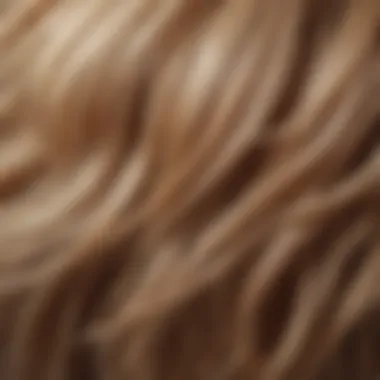Understanding Wigs: Styles, Materials, and Care Guide


Intro
Wigs have known a remarkable journey across cultures and historical epochs. Once simply tools for practicality or concealment, they have blossomed into vibrant extensions of personal style and fashion statement. In an age where self-expression is deeply valued, wigs provide an elaborate canvas for creativity. This guide aims to navigate through the ocean of wig options, materials, and care practices while embracing the evolving fashion landscape.
The importance of understanding wigs goes far beyond mere aesthetics. Today, whether it’s a casual outing or a high-fashion runway, wigs are becoming integral parts of our wardrobe, addressing various needs from covering hair loss to offering an easy way to switch up one’s look without permanent changes. Readers — especially stylists, designers, and students — will find this exploration offers not just the basics but skilled insights into how one can seamlessly integrate wigs into their own style or professional work.
"A wig is not just hair; it's a transformation of self."
With this guide, you’ll dive into fashion trends that showcase how wigs can fit into the latest styles, learn practical tips on wearing them, and explore materials that make them look and feel authentic. Embrace the journey of understanding wigs — and let it inspire your personal style journey as well.
Prolusion to Wigs
Wigs have long held an esteemed place in culture and fashion, serving both aesthetic functions and practical needs. In today’s increasingly diverse world of beauty and personal expression, understanding wigs is vital. They can dramatically change a person's appearance or help someone regain confidence after hair loss due to medical conditions. By comprehending the various styles, materials, and care routines of wigs, stylists, designers, marketers, and students can better appreciate their versatility and significance.
Historical Background
The story of wigs is as rich and intricate as the pieces themselves. Historically, wigs have been worn for centuries. Ancient Egyptians fashioned wigs from palm fibers and human hair to shield themselves from the sun while symbolizing status. In fact, the more elaborate a wig was, the greater the social standing it indicated. Moving to the 17th century, wigs took on a more ornamental role, especially in Europe. Aristocrats wore towering styles, often adorned with ribbons and other trimmings, to convey wealth and sophistication.
Moreover, the use of wigs has evolved in various societies, with their purpose shifting alongside changing fashions. From the powdered wigs of French nobility to the beaded cornrows of African cultures, each style conveys a unique narrative steeped in tradition and identity. In modern times, wigs have not only found their place on the heads of fashion-forward individuals but have also become crucial tools in the film and theater industry, facilitating character transformations that allow actors to slip into their roles seamlessly.
Cultural Significance
Wigs are more than simple accessories; they hold deep cultural meanings across the globe. For many, wearing a wig can embrace cultural heritage or express individuality. In African American communities, wigs and hairpieces are often seen as a celebration of beauty, versatility, and creativity. Styles can carry historical significance while fostering artistic interpretation.
The cultural portrayal of wigs extends further into the entertainment sector, influencing trends and societal perceptions of beauty. Celebrities frequently don wigs to redefine their looks swiftly, setting trends that are eagerly followed by fans around the world. For instance, the impact of pop icons like Beyoncé or Lady Gaga often leads to a surge in specific wig styles, showcasing their ability to transform personas almost overnight.
"Wigs can symbolize empowerment, allowing expression beyond natural limitations, enabling people to present who they want to be to the world."
Additionally, the advent of social media has amplified the cultural relevance of wigs, as individuals share their styling journeys and wig tutorials, fostering a community built on shared experiences and creativity. By understanding the historical and cultural tapestry of wigs, one can appreciate not just their aesthetic appeal but also their significance in personal expression and societal narratives.
Types of Wigs
Wigs have stood the test of time, serving both practical and aesthetic needs. Their importance extends beyond mere fashion; understanding the different types of wigs is crucial for anyone considering a purchase, whether for everyday wear, special events, or theatrical performances. Each type of wig offers its own set of features and benefits. By delving into the specifics—like material composition, styling options, and maintenance—wearers can make informed choices that align with their individual preferences and lifestyles.
Synthetic Wigs
Synthetic wigs are often the go-to choice for those seeking a budget-friendly option without compromising on style. Made from man-made fibers, these wigs come pre-styled, which means they can save time in the morning hustle. For casual users, synthetic wigs are quite versatile; they can hold their shape well, making them suitable for various outings, from grocery trips to night-outs.
However, prospective buyers should be aware that synthetic wigs have their limitations. Exposure to heat can lead to irreparable damage, so styling tools should be steered clear of unless explicitly labeled as heat-resistant. Additionally, the longevity of synthetic wigs is typically less than that of their human hair counterparts. This makes regular replacement necessary, but at a moderate cost.
Human Hair Wigs
When it comes to authenticity and styling options, human hair wigs can't be beaten. These wigs are made from real human hair, offering the most natural look and feel. They allow for versatile styling—coloring, curling, and cutting are all possible. This flexibility makes them an excellent choice for those who want a wig that feels just like their own hair.
Nevertheless, caring for human hair wigs requires a fair bit of commitment. Regular washing, conditioning, and maintenance are essential to keep the hair looking fresh and lively. Moreover, the initial investment can be quite hefty, making these wigs more suitable for dedicated users. If folks are willing to put in the effort, though, human hair wigs can last for many years, making them a worthwhile investment.
Lace Front Wigs
Lace front wigs combine the best of both worlds. They feature a lace base at the front, allowing for an incredibly natural hairline. This design makes them ideal for styles that involve pulling hair back or away from the face, giving the illusion that hair is growing directly from the scalp.
The versatility of lace front wigs is one of their major selling points. They can be styled in numerous ways—braids, ponytails, or even just loose waves. Wearers can also opt for a variety of colors and lengths. However, it is essential to note that the lace material can be delicate. Proper handling and care are necessary to avoid tearing, and adhesives used for secure attachment should be chosen with care.
Full Lace Wigs
Full lace wigs offer even more styling flexibility than lace front wigs, as the lace extends across the entire cap. This makes it possible to part the hair in any direction, providing flexibility for hairstyles. They are often favored by individuals wanting complete control over their look.
That said, full lace wigs can involve a steeper learning curve for those new to wigs. Proper installation and adjustment can take time, but the results can be stunning. The breathable lace material is comfortable, allowing for all-day wear, a feature that those who need to wear a wig regularly find beneficial. As with lace front wigs, application of adhesives should be approached thoughtfully to ensure a secure fit without damaging the lace.


In summary, the type of wig that one chooses greatly depends on lifestyle, styling preferences, and budget. Each kind has its unique advantages, making it essential for wearers to consider their specific needs before making a purchase.
Materials Used in Wigs
Understanding the materials used in wigs is critical not just for making an informed purchase, but also for ensuring proper maintenance and satisfying results. Different materials bring their own strengths and weaknesses to the table, which affects not just appearance but also comfort, durability, and styling potential. By familiarizing oneself with the nuances of these materials, individuals can better navigate the vast array of options available in the market.
Types of Synthetic Fibers
Synthetic wigs are made from a range of fibers that mimic the appearance and texture of natural hair. Two main types of fibers dominate this category: Kanekalon and Toyokalon.
- Kanekalon is known for its softness and ability to hold styles well, making it a popular choice among synthetic wigs.
- Toyokalon, on the other hand, is often regarded as being a bit lighter and more heat-resistant, providing a look that can be styled with heat tools, although with some restrictions.
Both types of synthetic fibers can be more affordable than human hair, making them accessible for those experimenting with different styles without breaking the bank. However, they are also less versatile when it comes to styling. With synthetic wigs, a user must often rely on pre-styled looks, which limits spontaneity.
Quality of Human Hair
When it comes to hair wigs made from real human hair, quality can be quite variable. Many human hair wigs are categorized by sources and processing methods:
- Remy Hair: This is the highest quality available, as all the cuticles are intact and aligned. This minimizes tangling and allows for more natural movement.
- Non-Remy Hair: It can come from multiple donors and often undergoes a chemical process to strip the cuticles, resulting in a more affordable wig, but at a sacrifice in longevity and naturalness.
Choosing a human hair wig requires careful consideration of these quality factors. Higher-quality wigs tend to last longer and offer more styling flexibility. They can be treated much like your natural hair—washed, styled, and dyed.
Comparison of Wigs Materials
When comparing synthetic and human hair wigs, several key factors come into play:
- Appearance: Human hair often appears more natural, while synthetic wigs may shine too much under bright light.
- Maintenance: Synthetic wigs typically require less upkeep—just occasional washing—but may lack longevity compared to human hair, which requires regular washing and conditioning.
- Styling: Human hair wigs offer more versatility in hairstyling, while synthetic wigs may require specific styling products to maintain their shape.
- Cost: Generally, synthetic wigs are cheaper than their human hair counterparts, making them a cost-effective solution for those on a budget.
"The choice between synthetic and human hair wigs shouldn't just depend on price. Evaluate how often you intend to wear the wig, and your styling aspirations, to select the best material for your needs."
By weighing these factors carefully, one can find a wig that aligns seamlessly with personal style and lifestyle. Armed with this insight into wig materials, stylists, designers, and marketers can navigate the intricate world of wigs with greater confidence.
Choosing the Right Wig
Selecting the right wig can make all the difference in creating a look that resonates with personal style and comfort. A well-chosen wig not only enhances appearance but can also boost confidence and self-esteem for those who wear them. Thus, it’s vital to take various factors into account when settling on a wig. Different aspects come into play such as face shape, color, and fit, all pivotal in ensuring a natural and visually appealing result.
Face Shape Considerations
When it comes to wigs, face shape plays a significant role in how a wig can frame one's features. Different styles may highlight or mask certain characteristics. Knowing whether your face is oval, round, square, or heart-shaped can guide you in selecting a wig that complements your unique visage. For example, round faces often benefit from longer, layered styles that elongate the appearance, while square faces can soften harsh angles with softer, curly wigs.
Key considerations include:
- Oval Faces: Almost any style works, but long, straight wigs add elegance.
- Round Faces: Look for volume at the crown to elongate the face.
- Square Faces: Soft waves or curls soften the angles.
- Heart-Shaped Faces: Shoulder-length styles with layers channel down the chin and balance the width of the forehead.
By keeping these considerations in mind, the chosen wig can enhance features rather than detract from them, creating a polished look.
Color Selection Tips
Color selection can indeed set the tone for your wig look. The palette of your hair can dramatically affect your overall style and mood. It’s crucial to choose colors that not only match your skin tone but also reflect your personality.
- Choose the Right Shade: For cooler skin tones, ashy or platinum shades work well, while warmer tones usually harmonize better with rich, golden hues.
- Highlighting and Lowlighting: Adding dimension through highlights or lowlights can create a natural appearance, giving your hair depth and movement.
- Try Before You Commit: Whenever possible, test out wigs in varied lighting, as colors may differ in natural and artificial light.
Ultimately, color is not just about matching; it should tell your story.
Size and Fit Guidelines
Fit is paramount in choosing a wig that feels comfortable and looks natural. Wearing a poorly fitting wig can distract from the intended aesthetic, and it might be uncomfortable as well. Here are some practical tips to ensure an optimal fit:


- Measure Your Head: Use a fabric measuring tape to gauge your head circumference. Measure around the head from the hairline at the forehead, around the ears, and back to the nape of the neck. This will determine your wig size.
- Adjustable Straps: Many wigs come with adjustable straps that can easily be modified for a snug fit.
- Cap Construction: Look into the wig cap styles that suit your needs: full lace, lace front, or a traditional cap. Each has its own fit and comfort level.
A well-fitting wig not only enhances your overall style but also contributes positively to your comfort throughout the day. The right wig can be the cherry on top of your personal style, enabling you to express yourself with flair.
"The best part of a wig is its power to enchant. Choosing the right one is the first step in making magic happen!"
Choosing the right wig can very well be the missing piece in a well-curated aesthetic. With careful consideration of face shape, color, and fit, one can find that perfect wig that feels like a second skin, turning heads wherever one may roam.
Wig Maintenance and Care
Wig maintenance and care are cornerstones of ensuring longevity and optimal appearance. A well-cared-for wig not only enhances a person’s look but also represents an investment in their personal style. When it comes to using wigs, whether for fashion, function, or both, understanding maintenance can elevate one’s experience from merely wearing a piece of hair to genuinely enjoying it. Proper care aligns with the quality of the wig, the materials it’s made from, and individual styling preferences.
Cleaning Techniques for Synthetic Wigs
Synthetic wigs can be a bit trickier when it comes to cleaning, yet regular upkeep is essential. It’s important to remember that these wigs have fibers that don’t react the same way as natural hair. Here are some effective cleaning techniques:
- Use wig-specific shampoo: Regular shampoos may contain harsh chemicals that could break down synthetic fibers. Look for gentle cleansers specifically designed for wigs.
- Cold water rinse: When washing the wig, always use cold water. Hot water can damage synthetic fibers by causing them to lose shape.
- Gentle scrubbing: Avoid vigorous scrubbing. Instead, swirl the wig gently in a bowl of soapy water, then rinse it carefully. This helps to remove dirt without damaging the fibers.
- Conditioning: Use a wig conditioner to keep the fibers soft and manageable. Apply a small amount through your fingers and avoid the roots.
- Drying: Lay the wig flat on a towel or a wig stand to let it air dry. Direct heat from a hairdryer should be avoided as it can cause frizz and tangling.
Grooming Human Hair Wigs
Grooming human hair wigs requires a bit more finesse, paralleling the routine you might undertake for your natural hair. Human hair wigs can be styled, curled, and colored, but they also need attention to maintain their vitality.
- Detangling: Always detangle the wig before washing using a wide-tooth comb. Start from the ends, working your way up to avoid breakage.
- Washing schedule: Depending on usage, wash your human hair wig every 7 to 14 days. Less frequent washing preserves the natural oils and overall quality.
- Heat tools: Use heat styling tools sparingly. If you do, always apply a heat protectant spray to shield the hair during styling. Remember that human hair wigs can withstand heat like natural hair, but overdoing it can lead to damage.
- Regular trims: Just like real hair, human hair wigs can develop split ends. Regular trims can keep the style fresh and healthy, ensuring it remains flattering.
Storage Practices to Extend Lifespan
Proper storage is as significant as regular maintenance in enhancing a wig's lifespan. Here's how to keep your wig looking fabulous for ages:
- Wig head or stand: Store your wig on a wig head or a stand. This keeps its shape intact and prevents tangling and flattening.
- Cool, dry place: Store the wig in a cool, dry area away from direct sunlight. Excessive exposure to sunlight can fade colors, especially in synthetic wigs.
- Protective netting: Use a wig cap or netting to prevent dust buildup and tangling during storage. It’s a practical measure that ensures your wig is ready-to-wear at any moment.
- Travel considerations: If traveling, place your wig in a designated wig box or a soft bag to protect it from bumps and bruises.
Proper maintenance and care of wigs not only increases their lifespan but also enhances the wearer’s confidence and appearance.
By following these maintenance techniques, both synthetic and human hair wig users can ensure their wigs stay vibrant, stylish, and in great condition for longer periods. It's the little things that can make a world of difference when it comes to self-expression through wigs.
Styling Wigs
Styling wigs is not just about making something look good; it’s about personal expression, versatility, and enhancing one's individuality. When someone opts for a wig, they often do so to elevate their appearance or even transform their identity. The world of wigs offers a myriad of styling possibilities, establishing them as a popular choice for those who wish to experiment with their look without the long-term commitment of hair dye or cuts. By understanding the nuances of styling wigs, wearers can ensure they not only look their best but also extend the life and health of their wigs.
Heat Styling: What You Need to Know
When it comes to heat styling wigs, there are some essential bits of information one must keep close to their heart. First and foremost, heat damage is a very real concern; synthetic wigs typically can't handle high temperatures, while human hair wigs can generally withstand a bit of heat. But how do you know which wig you have? Most quality wigs come with care labels that indicate whether heat styling is safe.
A few tips to consider:
- Use the Right Tools: Stick to lower temperatures and use styling tools specifically designed for wigs. Look for tools that have heat settings for more control.
- Protect your Wigs: There are heat protectant sprays available that can help minimize damage. Apply a light mist before using heated tools.
- Test First: Fancy trying a new styling technique? Always test on a small, hidden section. Better safe than sorry, right?
To wrap it up, maintaining the integrity of a wig while styling can be tricky, but it’s worth it when you see the final result.
Customizing Wigs for Personal Style
Customizing a wig can transform it from a standard piece into a true representation of one’s personality. This process is both rewarding and practical, allowing stylists to create unique looks that cater to individual tastes. One of the benefits of customizing is the ability to match the wig’s style and color to one’s wardrobe or specific occasions.
Some key considerations in customizing wigs:
- Alteration of Length: If you fancy a new look, cutting or trimming a wig can dramatically change it. Just remember, measure twice, cut once!
- Color Changes: Adding highlights or dyeing to achieve an ombre look is possible with human hair wigs, giving them a tailor-made touch. Synthetic wigs, however, have limitations with color treatments.
- Styling Enhancements: Fancy some curls or waves? Use styling tools or even hot rollers to give your wig that personalized flair. Just remember to ensure that it is safe for the type of wig you have.
"Personalizing your wig is like dressing up for your life; it sends a message about who you are and how you want to be perceived."


Wigs in Popular Culture
Wigs have entrenched themselves in the fabric of popular culture, acting as a canvas for self-expression and a symbol of innovation in both fashion and media. From the extravagant styles of the past to modern-day staples, wigs reflect not just personal identity but also broader societal trends. In this exploration, we’ll delve into how wigs influence pop culture, shedding light on their role in shaping identity, public perception, and the ever-evolving landscape of fashion.
Influence of Celebrities
Celebrities are often seen as trendsetters, their choices influencing fans worldwide. Wigs play a monumental role in this dynamic. Stars like Lady Gaga and Nicki Minaj have used wigs to create their signature looks, transforming themselves from ordinary individuals into iconic figures.
- Bold Colors: Celebrities like Katy Perry often use vibrant wigs to match their mood or theme for an event. This daring use of color defines their brand and keeps fans wanting more.
- Iconic Transformations: Think of Beyoncé who has rocked everything from chic bob cuts to long flowing locks in various shades. These variations allow her to blend into any persona, whether she’s channeling glamor or casual chic.
- Inclusivity in Fashion: Not only do celebrities set trends, but they also promote acceptance. More inclusive portrayals of diverse hairstyles in media make wigs a tool for empowerment.
The impact is often immediate and profound. When a beloved celebrity dons a new wig style, it's not long before fans flood beauty stores to replicate that look, showcasing the potent influence of celebrity culture on hair fashion.
Wigs in Film and Television
The film and television industries have long recognized the ability of wigs to transform characters and elevate storytelling. Characters who wear wigs often leave lasting impressions on audiences, becoming iconic in their own right.
Take for instance Dynasty—the 1980s soap opera that boasted some of the most memorable wig moments in television history. Joan Collins, with her elaborate hairpieces, embodied the glamour and excess of the era.
- Character Development: Wigs help in immediate character establishment. For example, in the series Game of Thrones, Daenerys Targaryen’s platinum blonde wig symbolizes her journey from exiled princess to fierce ruler.
- Era Representation: Historical dramas like The Crown feature wigs that are not just accessories but are critical in conveying the authentic era's aesthetic, transporting audiences back in time.
- Fantasy World Building: In many fantasy settings, wigs allow for greater creativity in character design, as seen in productions like Star Wars with its eclectic range of intergalactic styles.
"In the world of film and television, wigs are not merely props; they are essential tools for storytelling and identification."
The Future of Wigs
As the world continues to embrace changes in fashion, technology, and sustainability, the future of wigs is rife with potential. The advancements in this industry not only reflect innovations that enhance usability and style but also align with shifting consumer values, particularly around environmental responsibility. In this section, we will explore two key facets shaping the future of wigs: innovations in wig technology and sustainability practices in wig manufacturing.
Innovations in Wig Technology
Wig technology has made leaps and bounds in the past few years, and the future looks even brighter. Here, we unpack several noteworthy advancements:
- Smart wigs: Imagine a wig that can change colors via an app on your phone. Smart wigs are already on the horizon, incorporating LED technology to allow wearers to switch hues and even patterns, catering to those who desire versatility.
- 3D Printing: The rise of 3D printing is revolutionizing wig production. This technology allows for custom-fit wigs that are crafted based on the wearer's precise measurements. It's like wearing a tailored suit, but for your hair. The accuracy of fit will create a more natural look and feel.
- Improved Lace Materials: The materials used in lace front wigs are evolving. New lace types feature ultra-thin designs that create an almost invisible hairline, enhancing realism. This progression encourages more individuals to experiment with various styles without fear of detection.
- Heat-Resistant Fibers: The development of new synthetic fibers that withstand heat ensures visibility even in hotter climates. This grants wig wearers the freedom to use heated styling tools without alter the structure of their synthetic wigs.
"The rise of innovation in wig technology symbolizes a shift toward personalization and unprecedented versatility for consumers."
These innovations not only enhance the aesthetic appeal of wigs but also address practical challenges faced by users, truly placing the future in the wearers' hands.
Sustainability Practices in Wig Manufacturing
As awareness of environmental issues grows, wig manufacturers are adapting by implementing sustainable practices. It’s becoming increasingly essential for brands to consider the ecological footprint of their products. Here, we examine some key sustainability approaches:
- Eco-Friendly Materials: Brands are exploring the use of recycled and biodegradable materials in wig production. Such initiatives can help reduce waste and reliance on non-biodegradable synthetic fibers that burden landfills.
- Ethical Sourcing: With the increasing demand for human hair wigs, ethical sourcing has come into focus. Companies are ensuring that the hair used in their products is sourced from donors who give consent, promoting fair trade practices in the industry.
- Energy-Efficient Manufacturing: By streamlining production processes and employing energy-efficient machinery, manufacturers are reducing their carbon footprint. This exemplifies the shift towards more environmentally friendly operations.
- Recycling Programs: Some brands are taking the lead in offering recycling programs for used wigs. This ensures that discontinued or damaged wigs do not contribute to waste, setting a standard for accountability and customer involvement.
Finale
In this article, we have ventured into the intricate world of wigs, examining their designs, materials, and essential care tips. The importance of this conclusion lies in summarizing the significant insights we've gathered, and it serves as a reminder of the versatility and utility of wigs in personal expression.
Wigs are not just fashion accessories; they fulfill a variety of needs for different individuals. Whether you are looking to change your appearance for a special event or seeking a solution to hair loss, wigs can be a game-changer. Understanding the various types of wigs and their respective materials can influence your decision on which wig best suits your style and requirements.
Recap of Key Points
To ensure that readers leave with a solid grasp of what we've discussed, here are the main points:
- Types of Wigs: From synthetic to human hair, each offers different feels and appearances.
- Materials: The choice between synthetic fibers and natural hair can affect maintenance and styling options.
- Choosing the Right Wig: It’s crucial to consider face shape, hair color, and fit.
- Maintenance: Keeping wigs in prime condition requires specific care routines tailored to the wig type.
- Styling: The evolving trends in wig styling can help enhance one’s fashion statement.
- Cultural Impact: Wigs have a rich history and continue to play significant roles in pop culture and personal identity.
- Future Innovations: The wig industry is moving towards sustainable practices and technological advancements, shaping what’s to come.
Final Thoughts on Wigs
As we close this exploration, it is evident that wigs hold more than aesthetic appeal; they represent a blend of style, identity, and practicality. As trends evolve, and awareness grows about the potential of wigs, it is vital to remain informed.
Identifying what kind of wig complements not just your style but also your lifestyle can make a world of difference. In future interactions with styling and care, remember that wigs enable you to portray different facets of yourself, whether it’s for a casual day out or an important occasion.
As always, embrace your journey in the world of wigs with both confidence and curiosity.
"Wigs symbolize not just beauty, but also freedom - the freedom to express oneself without limits."
By staying engaged with modern practices and developments in the world of wigs, one can continually refine personal style and adapt to ever-changing trends.















